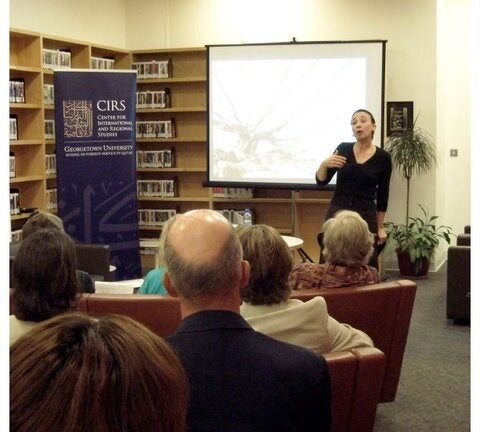Dialogue Series, Environmental Studies, Regional Studies
Renee Richer on Environment and Industry in Qatar

“Beauty and the Beast: Environment and Industry in Qatar”
CIRS kicked off its Monthly Dialogue Series on September 15, 2008, with a lecture by Renee Richer, Visiting Assistant Professor of Biology at Weill Cornell Medical College in Qatar. Richer’s presentation included a photograph slide-show of diverse life-forms that are rarely seen but are nevertheless indigenous to the desert environment and to Qatar. She pointed out that the desert is mistakenly perceived to be devoid of life-forms, but there is a fantastic array of biodiversity in both the marine and terrestrial environments beyond the boundaries of urban areas.
Richer’s lecture focused on putting into context an assumption that is often taken for granted, namely that strict environmental rules automatically work in reducing environmental damage. Richer questioned this hypothesis by giving evidence from primary research she had conducted on the state of environmental protection in Qatar.
Although Qatar recently adopted strict laws regarding the allowable amount of toxic particulate matter in air or water, she stressed that environmental protection can only be achieved if all surrounding countries adhered to the same standards. If Qatar imposes strict air and water regulations and its neighboring countries do not, then its environmental objectives cannot be met. Richer suggested that environmental pollution is a regional problem and not one that can be adequately addressed within the borders of just one country. Gulf countries should attempt to standardize their laws and work in tandem toward their enforcement.
In order to assess the state of environmental protection in industrial areas, Richer focused on Ras Laffan and Messaid, which have a concentration of large industrial plants and are, therefore, subject to greater levels of environmental degradation.
Pearl Oyster Case-Study
One of the case-studies Richer spoke of described the environmental degradation resulting from the impact of industrial cooling water on the surrounding marine environment, especially on the pearl oyster. In order to understand the problem, Richer explained, we must understand the industrial systems that are causing the localized environmental damage. Large industrial plants use huge amounts of energy and electricity, and the machinery used in their production require vast amounts of seawater as a cooling mechanism. Pearl oysters inhabiting these areas become entrapped in the iron filters and their build-up can reduce the industrial plant’s efficiency. In order to rid the filters of the marine life-form accumulation, the industry then pours tons of chlorine into the water. This not only rids the cooling system of pearl oysters, but also results in eradicating many marine organisms in the surrounding areas. At one point in Qatar’s history, the pearl oyster was the cornerstone of the economy, but now that energy plants have replaced them as the primary form of economic activity, the pearl oyster’s existence has become of peripheral importance.
Some organizations are beginning to attempt to adhere to the philosophy of environmental conservation by trying to find a medium between healthy productivity and a healthy environment. One industrial complex in Ras Laffan has solicited research into pearl oysters and has come up with a biologically-based solution to reducing the damage caused by the chlorination of cooling water. The results of the research suggested the use of “pulse chlorination,” which only releases chlorine into the water at set intervals, thereby reducing the harm done to the larger marine environment.
The alternative to chlorination of cooling water is for an industrial plant to perform a “shut-down” where the entire complex is disabled for maintenance purposes. This alternative has its own environmental consequences as the industrial plant must then go through a “start-up” phase, where there is a colossal surge of energy and electricity released into the atmosphere in the form of oxidants and harmful particulate matter.
Richer suggested that because a high level of particulate matter is already naturally present in a desert atmosphere, one interesting area of research would be to try to ascertain how much of Qatar’s atmospheric pollutants are industrially-produced. This would be useful in measuring the level of industrial emissions and seeing how much it deviates from the suggested levels. Some organizations have begun to undertake such studies, but corporations are notoriously guarded about their discoveries and do not share information with the public or with each other.
Richer argued that many organizations were applying environmental laws to their production facilities because they realize that it is actually a savvy business move and, therefore, it would reduce allegations of mismanagement and lawsuits in the long run.
Richer concluded on a positive note by saying that although Qatar is developing at an accelerated pace, because of its small population it is not too difficult to have community involvement in the direction that industrial projects take regarding the environment. She also noted that Qatar recently elevated the Supreme Council for the Environment to a ministerial level, which was a positive step in Qatar’s progress towards valuing the environment and halting its degradation.
Summary by Suzi Mirgani, CIRS Publications Coordinator.